Vonoprazan has recently been developed and approved for clinical use in Japan1 as a drug of the potassium-competitive acid blocker (P-CAB) class reported to reversibly inhibit gastric acid output through K+-competitive ionic binding to H+/K+-ATP-ase2 Vonoprazan has been shown to selectively accumulate in gastric parietal cells in the mucosal layer of the rat stomach,3 and gastric cracked mucosa (GCM), redness, white spots (WS), and gastric polyps (GP) have been reported as P-CAB-associated gastric mucosal lesions.4-10 However, only a few cases have demonstrated a causal relationship between vonoprazan and gastric mucosal lesions through long-term follow-up from before drug initiation to after its discontinuation.5,6ćWe herein report two cases in which GCM, WS, and GP newly appeared after the initiation of vonoprazan treatment and were followed up after switching to proton pump inhibitors (PPIs).
The study protocol was reviewed and approved by the Institutional Review Board of the National Hospital Organization Hakodate National Hospital (approval number: R5-0105001). Written informed consent was obtained from the patients for the publication of this brief report and accompanying images.
Case 1. A 67-year-old woman had taken vonoprazan (20 mg) once daily for gastroesophageal reflux disease (GERD). Esophagogastroduodenoscopy (EGD) performed before the initiation of vonoprazan treatment demonstrated atrophic mucosal changes in the gastric antrum due to past Helicobacter pylori infection, although no atrophic or mucosal changes were noted in the gastric body (Fig. 1A, B). EGD performed 1 and 2 years later demonstrated newly appearing GCM (Fig. 1CāE) and multiple WS and GP in the greater curvature of the lower gastric body on white-light imaging (WLI) (Fig. 1F), respectively. To provide further evidence, texture and color enhancement imaging (TXI) mode 1 and narrow-band imaging (NBI) highlighted the GCM, WS, and GP observed on close-up WLI (Fig. 1GāI). Furthermore, magnifying endoscopy with NBI (M-NBI) revealed WS to be rich in microscopic vessels on the mucosal surface (Fig. 1J). Repeated EGD performed 1 year after switching from vonoprazan to esomeprazole (20 mg) demonstrated no change in GCM, although the WS disappeared and the GP size decreased (Fig. 1K, L).
Case 2. An 81-year-old man had taken vonoprazan (20 mg) once daily for GERD. The patient had no history of H. pylori infection and tested negative for serum immunoglobulin G antibodies against H. pylori. EGD performed before the initiation of vonoprazan treatment revealed normal gastric mucosa, with no atrophic or mucosal changes in the gastric body (Fig. 2A). EGD performed 2 and 4 years later demonstrated newly appearing GCM and GP (Fig. 2B) and enlarged GP and newly appearing multiple WS in the greater curvature of the lower gastric body on WLI (Fig. 2C, D), respectively. GCM and WS observed on close-up WLI (Fig. 2E) were highlighted in both TXI mode 1 and NBI (Fig. 2F, G). M-NBI revealed the WS to be rich in microscopic vessels on the mucosal surface (Fig. 2H), and repeated EGD performed 1 year after switching from vonoprazan to esomeprazole (20 mg) demonstrated no change in GCM except for the disappearance of WS and a slight reduction in GP size (Fig. 2I, J).
In each case, a tissue biopsy from WS revealed a mucus pool within a dilated duct that tested positive for Alcianāperiodic acidāSchiff staining (Case 1, Fig. 3A, B; Case 2, Fig. 3C, D).
Our findings have important implications for clinical practice. Long-term follow-up after the initiation of vonoprazan revealed that GCM, WS, and GP newly appeared as P-CAB-associated gastric mucosal lesions, and that switching from vonoprazan to PPI led to clear changes in WS and GP, that is, their disappearance or reduction.
Nishiyama et al.7 characterized a white hemispheric protrusion observed during WLI as WS, whose surface is rich in microscopic vessels on M-NBI, thus reporting WS as a vonoprazan-associated gastric lesion. Additionally, Yoshizaki et al.8 have reported that WS (which they defined as āstardust gastric mucosaā) is endoscopically characterized as small white protrusions in the upper and middle parts of the stomach not amenable to elimination by washing and are histologically characterized as a mucus pool located within a dilated duct. Similarly, in this study, white hemispheric protrusions were shown to be present in the gastric body on WLI and image-enhanced endoscopy (TXI and NBI), which was later confirmed as such by a multidisciplinary diagnosis combining M-NBI and pathological findings. Thus, although gastrin levels were not measured in this study, vonoprazan-induced hypergastrinemia may have led to the dilation of the fundic glands and delayed or blocked mucus release, which likely accounted for the pathogenesis of WS.7,8 However, at present, the exact mechanisms involved remain unclear.
Although PPI-associated GP are well documented, reports on P-CAB-associated GP are few. Iwamuro et al.9 have reported a case in which hyperplastic and fundic gland polyps regressed after vonoprazan cessation. Subsequently, Goto et al.10 have reported another case in which replacement of vonoprazan with a histamine-2 receptor blocker led not only to shrinkage of the hyperplastic polyps involved, but also to an improvement of anemia. In both cases, the causal relationship between vonoprazan and the appearance of GP was unclear; however, the long-term follow-up of two cases in this study revealed that initiation of vonoprazan treatment led to the emergence of new GP (i.e., hyperplastic polyps). Further research involving pathological examinations is required to determine whether P-CAB-associated GP share the same mechanism of onset as those associated with PPIs.
The novelty of this report is that the long-term follow-up captured the appearance of GCM, WS, and GP after the initiation of P-CAB treatment, as well as changes in the mucosal lesions after switching to PPI in two patients. Further follow-up is required to determine if any further changes may occur in the morphology of GCM and GP over time.










